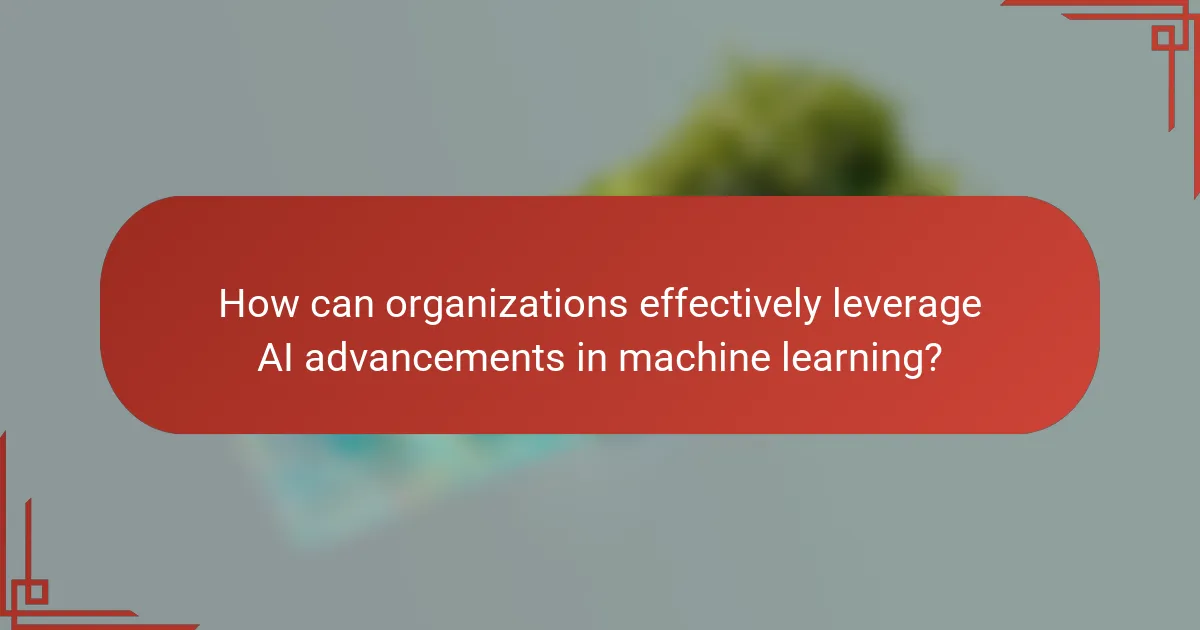The article focuses on AI advancements in machine learning, highlighting significant developments such as transformer models, reinforcement learning, and federated learning. Key examples include OpenAI’s GPT-4 for natural language processing, Google’s AlphaFold for protein folding prediction, and the role of AI in enhancing automation across industries like healthcare and finance. The article also discusses the projected growth of the machine learning market and emphasizes the importance of ethical AI development. Additionally, it outlines how organizations can leverage these technologies to improve efficiency, decision-making, and customer insights, demonstrating the tangible benefits of adopting machine learning advancements.

What are the latest AI advancements in machine learning?
Recent advancements in machine learning include the development of transformer models. These models have significantly improved natural language processing tasks. For example, OpenAI’s GPT-4 has shown enhanced understanding and generation of human-like text. Additionally, advancements in reinforcement learning have led to breakthroughs in robotics and game-playing AI. Google’s AlphaFold has made strides in protein folding prediction, impacting biology and medicine. Furthermore, federated learning has emerged, allowing decentralized data training while preserving privacy. These advancements are reshaping various industries, including healthcare, finance, and technology.
How have recent innovations changed the landscape of machine learning?
Recent innovations have significantly transformed the landscape of machine learning. Breakthroughs in deep learning architectures, such as transformers, have enhanced natural language processing tasks. These models, including BERT and GPT, enable more accurate language understanding and generation. Additionally, advancements in hardware, like GPUs and TPUs, have accelerated training times for complex models. The availability of large datasets has also improved model performance. Techniques like transfer learning allow models to adapt to new tasks with less data. Furthermore, automated machine learning (AutoML) tools simplify the model development process for non-experts. Collectively, these innovations have made machine learning more accessible and effective across various applications.
What specific technologies are driving these advancements?
Machine learning advancements are driven by several specific technologies. These include deep learning frameworks such as TensorFlow and PyTorch. They enable complex neural network architectures to be built and trained efficiently. Graphics Processing Units (GPUs) significantly enhance computational speed for training models. Cloud computing platforms provide scalable resources for data storage and processing. Natural Language Processing (NLP) technologies improve human-computer interaction through better language understanding. Additionally, big data analytics allows for the processing of vast datasets, leading to more accurate models. These technologies collectively contribute to the rapid evolution of machine learning applications across various industries.
How do these technologies improve machine learning outcomes?
Technologies such as advanced algorithms, big data analytics, and enhanced computational power improve machine learning outcomes. Advanced algorithms enable more accurate predictions and classifications. Big data analytics provides vast datasets for training, which enhances model performance. Enhanced computational power allows for faster processing and real-time analysis. These improvements lead to better decision-making and increased efficiency in various applications. For example, the use of deep learning has shown significant advancements in image and speech recognition tasks. According to a study by LeCun et al. (2015), deep learning has outperformed traditional methods in many benchmarks, demonstrating the effectiveness of these technologies in machine learning.
What are the key applications of AI in machine learning?
Key applications of AI in machine learning include image recognition, natural language processing, and predictive analytics. Image recognition uses algorithms to identify objects in images. This technology powers applications in security and social media. Natural language processing enables machines to understand and respond to human language. It is widely used in virtual assistants and chatbots. Predictive analytics leverages historical data to forecast future trends. Businesses use this in marketing and risk management. These applications demonstrate AI’s transformative impact on various industries.
In which industries is AI-driven machine learning making the most impact?
AI-driven machine learning is making the most impact in industries such as healthcare, finance, retail, and manufacturing. In healthcare, machine learning enhances diagnostics and personalized medicine. In finance, it improves fraud detection and risk assessment. Retail benefits from customer behavior analysis and inventory management. Manufacturing uses machine learning for predictive maintenance and quality control. These applications demonstrate significant efficiency improvements and cost reductions across sectors.
How is machine learning enhancing decision-making processes?
Machine learning enhances decision-making processes by analyzing large datasets to identify patterns. It provides insights that humans may overlook. Algorithms process data faster than traditional methods. This leads to quicker, data-driven decisions. Machine learning models can predict outcomes based on historical data. For example, in healthcare, predictive analytics improve patient outcomes by informing treatment options. In finance, machine learning helps assess risks and identify investment opportunities. These applications demonstrate the effectiveness of machine learning in improving decision accuracy and efficiency.
What challenges are faced in the implementation of machine learning?
Challenges in the implementation of machine learning include data quality, algorithm complexity, and resource constraints. Data quality issues arise from incomplete, biased, or noisy data, which can lead to inaccurate models. Algorithm complexity can make it difficult to understand and interpret results. Resource constraints often involve insufficient computational power and budget limitations. Additionally, there are challenges related to integration with existing systems and ensuring compliance with regulations. These factors can hinder the successful deployment of machine learning solutions across various industries.
What ethical considerations arise with AI advancements?
Ethical considerations arising with AI advancements include bias, privacy, accountability, and transparency. Bias in AI systems can lead to unfair treatment of individuals based on race, gender, or socioeconomic status. Research shows that algorithms can perpetuate existing societal biases if not properly managed. Privacy concerns arise from data collection practices, as personal information may be misused or inadequately protected. Accountability issues emerge when AI systems make decisions without clear human oversight, making it difficult to determine responsibility for outcomes. Transparency in AI operations is essential to build trust, yet many algorithms operate as “black boxes,” obscuring their decision-making processes. These considerations highlight the need for ethical frameworks in AI development to ensure responsible usage and societal benefit.
How do data privacy concerns affect machine learning applications?
Data privacy concerns significantly impact machine learning applications. These concerns limit the availability of data necessary for training models. Regulations like GDPR impose strict guidelines on data usage. Compliance with these regulations often requires anonymization or data minimization. This can reduce the effectiveness of machine learning algorithms. Additionally, organizations may face legal repercussions for data breaches. Such risks can deter investment in machine learning projects. Furthermore, public distrust over data handling may hinder user participation. Overall, data privacy concerns create challenges in developing robust machine learning solutions.

What are the future prospects of AI advancements in machine learning?
The future prospects of AI advancements in machine learning are promising and multifaceted. Machine learning is expected to enhance automation across various industries. This includes healthcare, finance, and transportation. For instance, predictive analytics in healthcare can improve patient outcomes. In finance, algorithms can detect fraudulent activities more effectively. Additionally, advancements in natural language processing will enable more sophisticated human-computer interactions. Research indicates that the global machine learning market is projected to grow from $1.41 billion in 2020 to $8.81 billion by 2025. This growth reflects the increasing adoption of AI technologies. Furthermore, ethical AI development will become a priority to address bias and transparency. Overall, the trajectory of machine learning indicates significant advancements that will reshape multiple sectors.
How is machine learning expected to evolve in the coming years?
Machine learning is expected to evolve through increased automation and improved algorithms. Advances in deep learning will enhance model accuracy and efficiency. New techniques like transfer learning will facilitate knowledge sharing across different tasks. Enhanced data availability will drive more robust training processes. The integration of machine learning with edge computing will enable real-time analytics. Ethical AI practices will become central to development, ensuring responsible use. Regulations will likely shape the landscape, influencing how models are trained and deployed. These trends indicate a significant shift towards more intelligent and autonomous systems.
What emerging trends should we watch for in AI and machine learning?
Key emerging trends in AI and machine learning include increased automation, enhanced natural language processing, and ethical AI development. Automation is transforming industries by streamlining processes and reducing human intervention. Enhanced natural language processing improves communication between machines and humans, enabling more intuitive interactions. Ethical AI development focuses on ensuring fairness, transparency, and accountability in AI systems. The integration of AI with edge computing allows for real-time data processing closer to the source, improving response times. Furthermore, advancements in generative AI are enabling the creation of original content, posing both opportunities and challenges. These trends reflect the ongoing evolution of AI and machine learning, shaping future applications and societal impacts.
How might these trends influence various sectors?
AI advancements in machine learning will significantly influence various sectors by enhancing efficiency and decision-making. In healthcare, machine learning can improve diagnostics and personalized treatment plans. For instance, algorithms analyze medical images faster and more accurately than human radiologists. In finance, AI can optimize trading strategies and detect fraudulent activities in real-time. Retail sectors benefit from personalized shopping experiences through predictive analytics. Manufacturing can achieve better supply chain management and predictive maintenance, reducing downtime. Education will see tailored learning experiences based on individual student performance data. Transportation can improve route optimization and autonomous vehicle technology, enhancing safety and reducing costs. These trends indicate a transformative impact across multiple industries, driving innovation and productivity.
What are the potential risks associated with future advancements?
Potential risks associated with future advancements in AI and machine learning include ethical concerns, job displacement, and security threats. Ethical concerns arise from biased algorithms that can perpetuate discrimination. Job displacement is a risk as automation may replace human roles in various sectors. Security threats include the potential for malicious use of AI in cyber attacks. These risks can lead to societal unrest and economic instability. Research by the Brookings Institution highlights these challenges in their report on the future of work and AI.
How can organizations mitigate risks in AI development?
Organizations can mitigate risks in AI development by implementing robust governance frameworks. These frameworks ensure compliance with regulations and ethical guidelines. Regular risk assessments should be conducted to identify potential vulnerabilities. Training for developers on bias and ethical AI practices is essential. Establishing clear accountability for AI decisions can enhance transparency. Collaborating with external experts can provide valuable insights into best practices. Continuous monitoring of AI systems helps to detect issues early. Engaging stakeholders in the development process fosters diverse perspectives and reduces blind spots.
What role does regulation play in the future of machine learning?
Regulation plays a crucial role in shaping the future of machine learning. It ensures ethical standards and accountability in AI applications. Regulations can address biases in algorithms, promoting fairness and transparency. They also establish guidelines for data privacy and security, protecting user information. Compliance with regulations can enhance public trust in machine learning technologies. Countries are increasingly developing frameworks to govern AI use. For instance, the EU has proposed the AI Act to regulate high-risk AI systems. Such regulations can influence innovation by setting boundaries for development and deployment.

How can organizations effectively leverage AI advancements in machine learning?
Organizations can effectively leverage AI advancements in machine learning by integrating these technologies into their operations. They can automate data analysis to gain insights faster and more accurately. Machine learning algorithms can predict customer behavior, enhancing marketing strategies. Organizations can also improve decision-making processes by utilizing predictive analytics. Implementing AI-driven tools can increase operational efficiency and reduce costs. Furthermore, training employees to work alongside AI systems ensures better utilization of these technologies. According to a McKinsey report, companies using AI have seen productivity increases of 20-30%. This demonstrates the tangible benefits of adopting machine learning advancements.
What best practices should organizations adopt for successful implementation?
Organizations should adopt a structured approach for successful implementation of AI advancements in machine learning. This includes defining clear objectives and aligning them with business goals. Engaging stakeholders early in the process ensures buy-in and support. Training employees on new technologies is crucial for effective utilization. Regularly monitoring progress and adjusting strategies based on feedback is essential for continuous improvement. Establishing a robust data governance framework protects data integrity and compliance. Collaborating with technology partners can enhance resource availability and expertise. Finally, fostering a culture of innovation encourages experimentation and adaptation to new AI solutions.
How can companies ensure they are using ethical AI in their machine learning processes?
Companies can ensure they are using ethical AI in their machine learning processes by implementing clear guidelines and frameworks. Establishing ethical guidelines helps define acceptable AI practices. Regular audits of AI systems can identify biases and ensure compliance with ethical standards. Training employees on ethical AI principles fosters a culture of responsibility. Engaging with diverse stakeholders provides varied perspectives on ethical implications. Transparency in AI decision-making processes builds trust with users. Monitoring outcomes of AI applications can help adjust practices to uphold ethical standards. Research indicates that organizations with ethical frameworks see improved public perception and accountability.
What strategies can enhance collaboration between AI and human intelligence?
Enhancing collaboration between AI and human intelligence can be achieved through several strategies. Firstly, establishing clear communication channels is essential. This allows both AI systems and humans to share insights effectively. Secondly, integrating AI tools into existing workflows can streamline processes. This integration enables humans to leverage AI capabilities in their tasks. Thirdly, fostering a culture of continuous learning is vital. Humans should be trained to understand AI functionalities, while AI systems can be updated based on human feedback. Fourthly, promoting interdisciplinary teams can enhance problem-solving. Diverse perspectives can lead to innovative solutions. Lastly, implementing ethical guidelines ensures responsible use of AI. This builds trust between AI systems and human users. Research shows that organizations adopting these strategies experience improved productivity and innovation.
What common pitfalls should organizations avoid when adopting AI advancements?
Organizations should avoid several common pitfalls when adopting AI advancements. One major pitfall is failing to define clear objectives for AI implementation. Without specific goals, AI projects may lack direction and purpose. Another pitfall is underestimating the importance of data quality. Poor data can lead to inaccurate AI models and unreliable outcomes. Additionally, organizations often overlook the need for cross-functional collaboration. Successful AI initiatives require input from various departments, including IT, operations, and business units.
Furthermore, organizations may neglect to invest in employee training. Employees need to understand AI tools to leverage their full potential. Another common mistake is ignoring ethical considerations. Organizations must address bias in AI algorithms to ensure fair outcomes. Lastly, organizations sometimes rush the implementation process. A phased approach allows for testing and refinement, reducing the risk of failure. These pitfalls can hinder the successful adoption of AI advancements in organizations.
How can organizations identify and address these pitfalls early?
Organizations can identify and address pitfalls early by implementing proactive monitoring systems. These systems should track key performance indicators (KPIs) relevant to AI projects. Regular audits of AI models can reveal biases or inaccuracies. Training staff on potential challenges in AI can enhance awareness. Engaging stakeholders in the development process fosters diverse perspectives. Utilizing feedback loops allows for continuous improvement of AI systems. Research indicates that early detection can reduce project failure rates significantly. For instance, a study by McKinsey found that companies that monitor AI performance closely see a 30% increase in project success.
What resources are available for organizations looking to improve their AI initiatives?
Organizations looking to improve their AI initiatives can access several valuable resources. These include online courses like those from Coursera and edX, which offer specialized AI training. Industry conferences such as NeurIPS and ICML provide networking opportunities and insights into the latest research. Open-source platforms like TensorFlow and PyTorch facilitate experimentation and development in AI. Additionally, consulting firms like McKinsey and Deloitte offer tailored advice and strategies for AI implementation. Research papers and journals, such as the Journal of Artificial Intelligence Research, provide peer-reviewed findings that can guide organizations. These resources collectively enhance knowledge and foster innovation in AI initiatives.
AI advancements in machine learning represent a rapidly evolving field characterized by significant innovations and applications across various industries. This article examines the latest developments, including transformer models, reinforcement learning, and federated learning, highlighting their impact on natural language processing, robotics, and data privacy. It also addresses challenges such as data quality and ethical considerations, while exploring future prospects and the role of regulation in guiding responsible AI development. Key applications in healthcare, finance, and manufacturing illustrate how machine learning enhances efficiency and decision-making processes.


